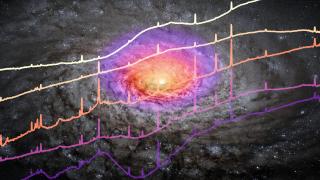Bibcode
Salvador-Rusiñol, N.; Ferré-Mateu, A.; Vazdekis, A.; Beasley, M. A.
Referencia bibliográfica
Monthly Notices of the Royal Astronomical Society
Fecha de publicación:
9
2022
Número de citas
12
Número de citas referidas
11
Descripción
Near-ultraviolet (NUV) spectroscopic studies have suggested that passively evolving massive, early-type galaxies host sub-one per cent fractions of young stars in their innermost regions. We shed light on the origin of these stars by analysing NGC 1277, a widely studied nearby prototypical massive compact relic galaxy. These are rare galaxies that have survived without experiencing significant size evolution via accretion and mergers since their formation at high redshift. We obtain a spectrum in the UV range within the central 1 kpc region of NGC 1277. We compare a carefully selected set of optical and NUV line-strengths to model predictions with star formation histories characteristic of massive galaxies. We find a 0.8 per cent mass fraction of young stars in the centre of NGC 1277, similar to that found in massive early-type galaxies. Given the limited accretion history of NGC 1277, these results favour an intrinsic, in situ, process triggering star formation at later epochs. Our results suggest a general constraint on the amount of young stars in the cores of massive early-type galaxies. This amount should be assumed as an upper limit for the young stellar contribution in massive galaxies, as there might be present other contributions from evolved stars.
Proyectos relacionados

Actividad Nuclear en Galaxias: una Perspectiva 3D del Núcleo y su Entorno
Nuestro proyecto puede dividirse en dos líneas principales de investigación. En primer lugar, el estudio de los vientos producidos por cuásares luminosos oscurecidos y del impacto que estos tienen en sus galaxias anfitrionas (retroalimentación del AGN). Para ello hemos obtenido observaciones en el óptico e infrarrojo cercano con el Gran Telescopio
Cristina
Ramos Almeida

Huellas de la Formación de las Galaxias: Poblaciones estelares, Dinámica y Morfología
Bienvenida a la página web del g rupo de investigación Traces of Galaxy Formation. Somos un grupo de investigación amplio, diverso y muy activo cuyo objetivo principal es entender la formación de galaxias en el Universo de una manera lo más completa posible. Con el estudio detellado de las poblaciones estelares como bandera, estamos constantemente
Anna
Ferré Mateu